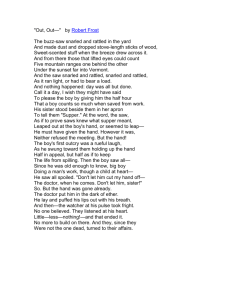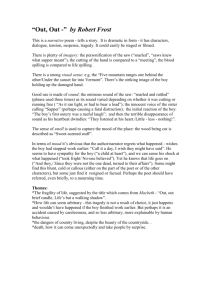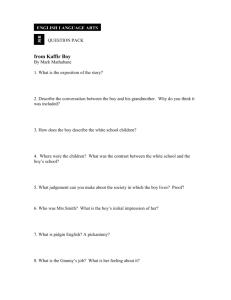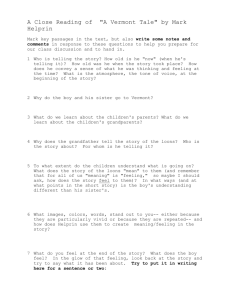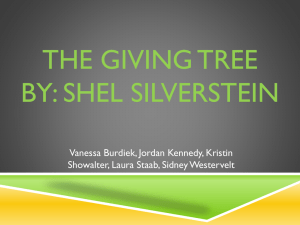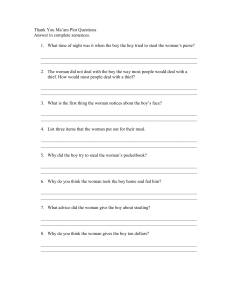OUT OUT - by Robert Frost
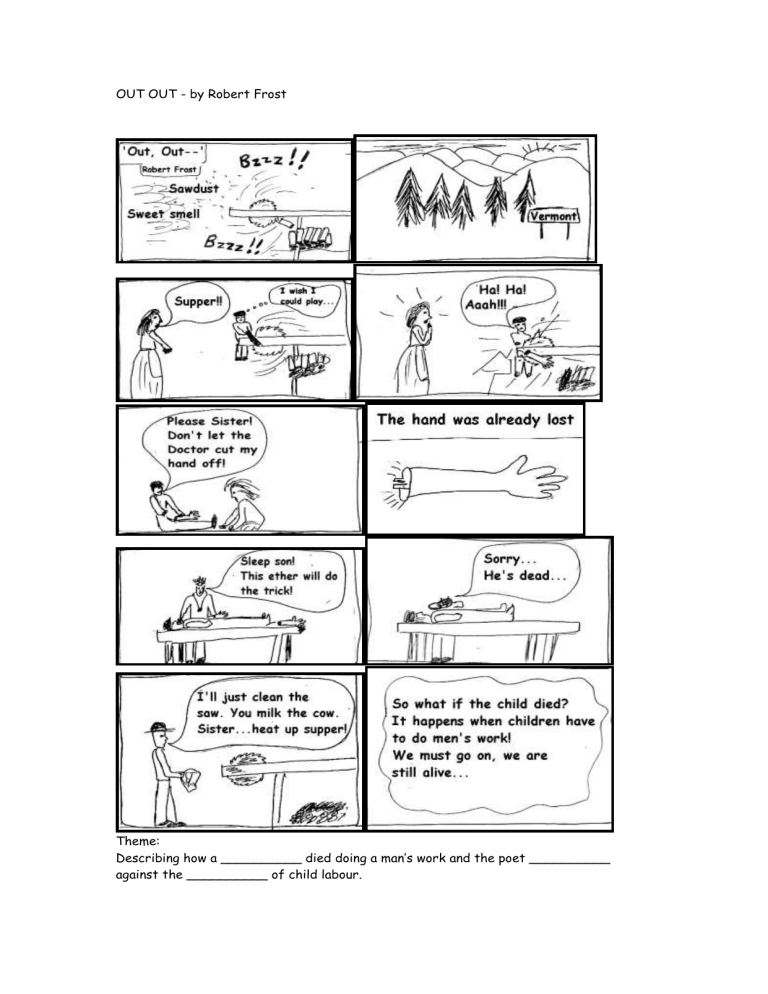
OUT OUT - by Robert Frost
Theme:
Describing how a __________ died doing a man’s work and the poet __________ against the __________ of child labour.
Type:
Lyric
STRUCTURE:
1. The poem which consists of 34 lines is divided into __________ stanzas
BACKGROUND
1. The title is taken from the __________ play ‘Macbeth’ in which the king on
__________ of his wife’s death thinks deeply on the __________ of man’s life which he compares to a short length of __________ that is soon burnt out.
“Out, out, brief candle!
Life’s but a walking shadow, a poor player that struts and frets his hour upon the stage and then is heard no more.”
2. The setting of the poem is a __________ in which a buzz saw (a circular saw so called for the sound it makes) was used to saw logs in to __________.
Line 1
The buzz saw snarled and rattled in the yard
The setting is Vermont. The story takes place at a sawmill where a circular saw is used to cut wood.
Snarled: this word shows that the saw is as dangerous as an animal bearing its teeth.
Rattled: this words shows that the saw is old. It does not run smoothly anymore.
Line 2
And made dust and dropped stove-length sticks of wood,
The saw made a lot of dust. This dust forms a contrast with the beautiful view they have of the mountain ranges. The workplace is noisy and dusty.
Alliterations: dust and dropped.
Line 3
Sweet-scented stuff when the breeze drew across it.
The wood had a sweet smell.
Irony: the sweet smell of the wood forms a sharp contrast with the dusty and dirty saw yard. You do not expect anything sweet in this environment.
Alliteration: sweet-scented stuff
Line 4-5
And from there those that lifted eyes could count
Five mountain ranges one behind the other
Under the sunset far into Vermont
From the yard you see mountain ranges. This is a beautiful place. It is at the end of the day, the sun is setting. You have people working while the sun is setting.
Antithesis The beautiful view forms a sharp contrast with the noise of the saw and the dust surrounding the workers.
Line 7-9
And the saw snarled and rattled, snarled an rattled,
As it ran light, or had to bear a load.
And nothing happened: day was all but done.
Repetition: The repetition of snarled and rattled shows you that the saw is busy the whole time. It also suggests that something dangerous is going to happen.
Ran light: when there is no wood in the saw
Bear a load: when the saw is cutting a piece of wood
Nothing happened: this was boring and monotonous work. They did the same thing for the whole day.
Day was all but done: maybe something will still happen before the day is over, although it is already sunset.
Line 10-12
Call it a day, I wish they might have said
To please the boy by giving him the half hour
That a boy counts so much when saved from work.
Call it a day: The poet interrupts his description with his own subjective opinion.
He wishes they let the boy stop with work a half hour before stopping time so that the boy can play a little bit.
The boy has no time to play and playtime is precious to every boy/child.
He emphasizes that the boy is only a child which will heighten the tragedy of this poem.
Line 13-14
His sister stood beside him in her apron
The tell them ‘Supper’….
The sister is also working. She must do all the housework, she must make dinner etc. The word apron tells you she is working in the house. Supper is written in quotation marks because it is the actual word the sister said.
She arrives to call the workers that supper is ready.
Line 15-18
…At the word, the saw,
As if to prove saws knew what summer meant,
Leaped out at the boy’s hand, or seemed to leap—
He must have given the hand….
Personification: the saw becomes something that understands words. When the word ‘supper’ was said, it came loose and jumped at the boys hand.
It seemed as if the boy gave his hand to the saw.
The word leap links with the word snarl earlier. The saw is like an animal that jumps at the boy’s hand.
Line 17-18
….However it was,
Neither refused the meeting. But the hand!
However it was: It does not matter how the hand landed in the saw, the outcome was tragic.
The saw and the hand did not protest meeting. The saw cut easily through the hand
But the hand! This shows the tragedy
The hand was lost.
Line 19
The boy’s first outcry was a rueful laugh
Rueful: a kind of laugh that show regret
Laugh: he does not laugh because losing his hand is funny, it is unbelievable to him that he has lost his hand, that his hand is cut off.
Line 20-22
As he swung toward them holding up the hand,
Half in appeal, but half as if to keep
The life from spilling…
Appeal: the boy wanted their help.
Life from spilling: He wanted to prevent the blood flowing from the wound.
Blood represents life.
Metaphor: Life refers to blood.
Line 22-24
…Then the boy saw all—
Since he was old enough to know, big boy
Doing a man’s work, though a child at heart-
All: his whole life, past and future
Old enough: the boy understood the reality of his life
Big boy doing a man’s work: if he could do a man’s work he could know about his future.
Child at heart: still a child. Shows how unfair this is. This emphasises how young the boy is.
Line 25
He saw all spoiled…
He had no hand.
He would not be able to cut wood again.
His life was over.
He would not get any other work with only one hand, he had no future.
He won’t be able to do physical labour anymore.
Line 25-26
… ‘Don’t let him cut my hand off—
The doctor, when he comes. Don’t let him, sister!’
The boy knows how important his hand is to him.
He asks the person who is closest to him to help him.
When he comes: it is if he is unsure when the doctor will arrive.
Line 27
So. But the hand was gone already
So: This word sums it all up. What to do now? Would the hand be saved. Is it as simple as the boy asks from his sister?
Gone already: it is too late.
But the hand: emphasises what is lost.
Line 28
The doctor put him in the dark of ether
Ether: an anaesthetic
Dark of ether: he received anaesthesia that knocked him out. This was dangerous and uncontrolled. In the dark he felt no pain.
Dark: oblivion, unaware of surroundings
Line 30
And then – the watcher at his pulse took fright
And then: to indicate that something worse is still to come, as if what happened already is not terrible enough.
Watcher: the doctor, one of the workers
Took fright: became concerned
Line 31-33
No one believed. They listened at his heart
Little – less – nothing! – and that ended it.
No more to build on there.
No one believed: they did not believe he was dying.
Little – less – nothing: regression
Little less: alliteration of l
That ended it: his life is over. His pulse stopped.
No more to build on there: he is dead. He has no future
Line 33-34
---And they, since they
Were not the one dead, turned to their affairs
They: co-workers and family. Repetition of they empasises that they were not caring and touched by the boy’s death.
Were not the one dead: they went on with their lives. They carried on with business.
Shows you the tragedy of the boy’s death. He worked his whole young life and now nobody cares that he is dead.
